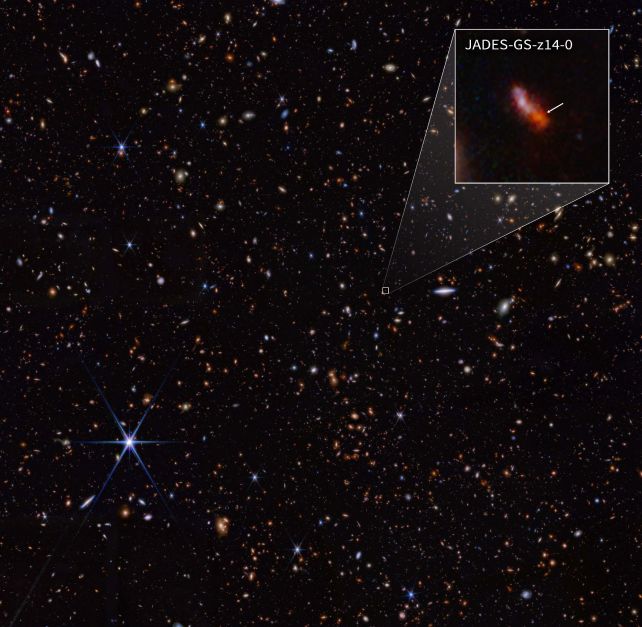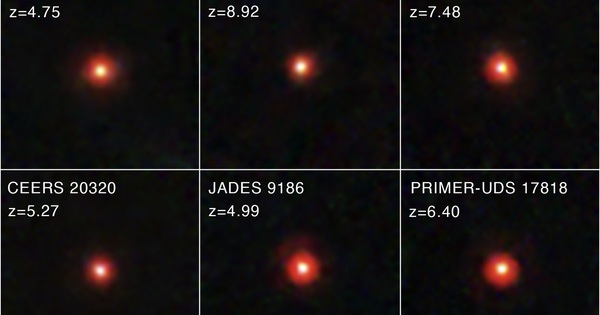(NLDO) - JADES-GS-z14-0, with a ghostly red color, is the oldest object mankind has ever seen.
According to Science Alert, the James Webb super telescope has just set a new record when it captured an image of an object named JADES-GS-z14-0, a galaxy that existed when the universe was only 290 million years old.
The universe - which began with the Big Bang event - is more than 13.8 billion years old, which means we are looking at a "trans-dimensional" object from a world more than 13.5 billion years ago.

Image from James Webb data with the extremely red object JADES-GS-z14-0 zoomed in - Photo: NASA/ESA/CSA
Astronomers Stefano Carniani from the Scuola Normale Superiore University (Italy) and Kevin Hainline from the University of Arizona (USA) identified the object using NIRSpec, the James Webb Spectroscopic Observatory's super-near-infrared spectroscopy instrument.
In January 2024, NIRSpec observed this galaxy, JADES-GS-z14-0, for nearly 10 hours. When the spectrum was processed, scientists were immediately surprised by its redshift of 14.32.
Redshift is a phenomenon that occurs when the source of radiation gradually moves away from the observer, causing the observed radiation to gradually shift towards the red end of the spectrum. Therefore, the object we see appears much redder than it actually is.
For astronomy, the redshift shows that the object has actually been pulled away from the position in the image we are observing, due to the expansion of the universe.
Telescopes can pick up light from very far away, but the light takes time to travel. So what James Webb is seeing billions of light years away is actually an image of what it looked like billions of years ago.
In the case of JADES-GS-z14-0, the above factors have inadvertently helped humanity obtain a "time-traveling" image of the galaxy when it was young, existing in the early universe.
That provides a direct look into the past, giving scientists more data about the mysterious period known as the "cosmic dawn," the first billion years after the Big Bang.
This ancient galaxy was surprisingly large and bright, completely unlike what astronomers had expected galaxies to look like during the "cosmic dawn."
Its size suggests that most of its light must come from stars, rather than the glow from space around a growing supermassive black hole. The galaxy is also incredibly rich in dust and oxygen.
The early universe contained only hydrogen and helium. The heavier elements had to be created inside stars, which then had to explode to disperse them.
So this super-red, super-bright object suggests that many generations of massive stars must have lived and died in the 300 million years or so after the Big Bang.
This supports a suspicion that the Cosmic Dawn was a period of extremely rapid cosmic growth, with supermassive stars born and dying in just a few million years, and galaxies actively growing and swallowing each other to reach large sizes.
What we see today is a universe that may be aging, slowing down, and becoming more stable.
Source: https://nld.com.vn/ky-luc-vat-the-hon-135-ti-nam-tuoi-xuyen-khong-den-trai-dat-196240601095302459.htm


![[Photo] President Luong Cuong receives Kenyan Defense Minister Soipan Tuya](https://vstatic.vietnam.vn/vietnam/resource/IMAGE/2025/4/17/0e7a5185e8144d73af91e67e03567f41)
![[Photo] Promoting friendship, solidarity and cooperation between the armies and people of the two countries](https://vstatic.vietnam.vn/vietnam/resource/IMAGE/2025/4/17/0c4d087864f14092aed77252590b6bae)
![[Photo] General Secretary To Lam receives French Ambassador to Vietnam Olivier Brochet](https://vstatic.vietnam.vn/vietnam/resource/IMAGE/2025/4/17/49224f0f12e84b66a73b17eb251f7278)
![[Photo] Prime Minister Pham Minh Chinh and Ethiopian Prime Minister visit Tran Quoc Pagoda](https://vstatic.vietnam.vn/vietnam/resource/IMAGE/2025/4/17/18ba6e1e73f94a618f5b5e9c1bd364a8)
![[Photo] Welcoming ceremony for Chinese Defense Minister and delegation for friendship exchange](https://vstatic.vietnam.vn/vietnam/resource/IMAGE/2025/4/17/fadd533046594e5cacbb28de4c4d5655)
![[Photo] Warm meeting between the two First Ladies of the Prime Ministers of Vietnam and Ethiopia with visually impaired students of Nguyen Dinh Chieu School](https://vstatic.vietnam.vn/vietnam/resource/IMAGE/2025/4/17/b1a43ba73eb94fea89034e458154f7ae)




![[Video] For the first time, businesses are not limited in spending from the Science and Technology Fund](https://vstatic.vietnam.vn/vietnam/resource/IMAGE/2025/4/17/c4916ce9668149c1ad4cfa0f81a084ec)








































![[Video] Viettel officially puts into operation the largest submarine optical cable line in Vietnam](https://vstatic.vietnam.vn/vietnam/resource/IMAGE/2025/4/17/f19008c6010c4a538cc422cb791ca0a1)







































Comment (0)